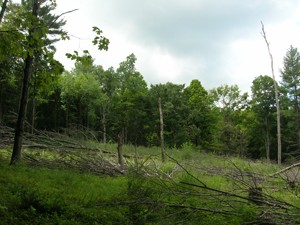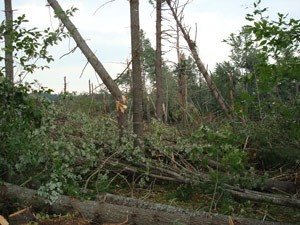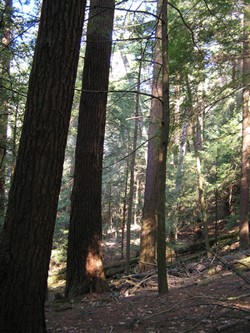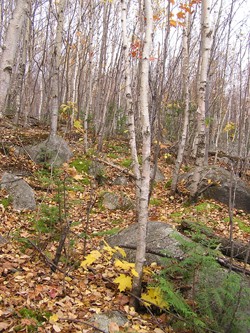In August 1, 1991, Hurricane Bob swept into southeastern New England with sustained winds of over 105 miles per hour. In its aftermath, we found that many large oaks in our family woodlot in Westport, Massachusetts, had been blown down or snapped off at a height of 10–20 feet. Instead of the high canopy of well-spaced trees that had resulted from careful thinning over the previous decades, much of the forest featured bright patches of sun that in the coming years would become a profusion of brush and vines.
Eighteen years later, thousands of new trees – red, scarlet, and white oak, red maple, and bitternut hickory – have broken through the brush layer and are well on their way to replacing the stand that was lost. In the end, these patches of storm-damage regeneration do not look all that different from the quarter-acre openings of deliberate clearing that we had created for wildlife diversity during an earlier timber harvest operation.
Natural disturbances, including hurricanes, ice storms, forest fires, and insect outbreaks, are a fact of life in the Northeast. In general, the size of these disturbances can be lumped into two broad categories: stand-replacing disturbances and gap disturbances. In forestry, a “stand” is an area within a forest that has trees with a similar range of ages and species. Stand sizes may measure from several acres to hundreds of acres, depending on forest type, uniformity of soil conditions, and land use history. A gap would be a hole within a stand of up to about two acres.
Stand-replacing disturbances result in the loss of the majority of the overstory of a forest stand. After such an upheaval, the process of forest growth and development begins from seed, established seedlings and saplings, and sprouts, resulting in a new stand of trees roughly the same age. Sometimes, scattered patches or individual trees from the original canopy remain.
Stand-replacing disturbances and large gaps encourage the regeneration and growth of trees that need abundant sun to become established, species such as paper birch and aspen. Black cherry, white ash, oaks, and pines can handle moderate amounts of shade. Other trees (maple and hemlock, for instance) can germinate and survive under a fully closed canopy, waiting patiently for gaps or stand-replacing disturbances to provide them room to grow.
Because a stand-replacing disturbance changes the physical structure of the forest, wildlife habitat shifts dramatically, and a suite of young-forest animal species replaces those of more mature forests. Young-forest birds such as the chestnut-sided warbler or ruffed grouse are likely to be found in regenerating hardwood forests after a stand-replacing disturbance, while species such as ovenbirds and red-eyed vireos will have lost their preferred breeding habitat.
Gap disturbances range in size from a single tree fall to an acre or two. While the impact of Hurricane Bob on my family’s woodlot looked severe when I first faced the tangled mess of once-valuable trees, each of the openings fell within the size range of a gap disturbance.
Wind, insects, diseases, ice storms, and fires ignited by lightning may be stand-replacing events, but in the Northeast, natural disturbances are far more likely to result in small canopy gaps. In the absence of a stand-replacing disturbance, forests that are subject to gap disturbances will, over time, develop many age classes of trees.

Agents of Change
For landowners and foresters planning future management practices in a forest stand, an important question is: how often can we expect a natural disturbance on a particular woodlot? The historical record provides some suggestions.
Major hurricanes have caused extensive blowdowns of forest stands and widespread gap disturbances in a belt across southern to central New England. Older residents can recall the infamous 1938 hurricane that blew down vast areas of forest from the southern New England coast well into Vermont, New Hampshire, and Maine. Researchers from the Harvard Forest estimate that a woodlot within the area south of a line from Boston to Hartford and central Long Island can expect a major hurricane on average every 85 years. Moving inland, any given spot within central Massachusetts and southern New Hampshire is likely to experience such a blow every 150 years, while a woodlot in southern Vermont, central New Hampshire, or coastal Maine could expect such an event about every 400 years on average. Pennsylvania and most of New York lie to the west of the major hurricane belt. [See hurricane map at end of article.]
Northern New England and New York can also be visited by spectacular blowdowns from other wind events, such as derechos (pronounced deh-RAY-cho), which are straight-line downdrafts that occur along frontal boundaries and cause damage over hundreds of miles. Residents of the Adirondacks and western Massachusetts may remember the 1995 derecho that caused moderate to severe damage on almost 90,000 acres of timberland.
In northern New England, New York, and Pennsylvania, stand-replacing disturbances from hurricanes and derechos are rare. Research suggests that an average location in the region might experience a stand-replacing blowdown affecting many hundreds or thousands of acres only once every 1,000–7,500 years. Gap disturbances, meanwhile, are quite common, generally affecting a given location within a stand once every 50–200 years. Thunderstorm-related downdrafts and microbursts are frequent causes of gap disturbances, as are insects infestations and disease outbreaks.
While we’re all familiar with news of devastating wildfires out West, fire also played a major role in the ecology of eastern forests before forest fire control became routine in the early 1900s. This was particularly true of the mixed oak-pine forests that characterize much of the landscape as far north as southern Maine and New Hampshire. In the spring and fall, when there are no leaves in the canopy, the sun dries oak leaves on the forest floor so that they will burn readily if ignited by lightning or human activities. Fast-burning ground fires that thin the understory, rather than stand-replacing crown fires, are most characteristic of oak-pine forests.
While oak and chestnut leaves burn well, northern hardwood (maple-beech-birch) forests grow in a cooler, moister environment that experiences very little natural fire. Spruce-dominated forests in the Northeast likewise burned infrequently; scientists estimate that lightning-caused fires in northern New England burned a given area roughly every 800–1,300 years.
Similar to wind and fire, ice storms can result in stand-replacing disturbances, gap disturbances, or some combination of the two. By far the majority of ice damage, even in major storms, results in scattered canopy damage that fits the gap-disturbance pattern. Major ice storms, however, also result in localized stand-replacing disturbances. Such disturbances are usually associated with certain elevations, tree species, and sizes in a given area. Very few stands are flattened by an ice storm, but heavy damage may result in destruction of enough of the canopy to lead to dense regeneration. New England has had two major ice storms in a 10-year period, and though the trend toward warmer winters may be a culprit, the lack of good long-term data on ice storms prevents scientists from determining whether the frequency of ice storms is increasing or not.
Native insects and diseases are also agents of canopy disturbance. Acting alone or in concert with other stressors such as drought and the process of dying, insects and diseases typically cause irregular but ongoing death of individual trees or small groups of trees, though the rate of mortality may increase when insect populations explode. Spruce-fir is the only regional forest type subject to stand-replacing native insect outbreaks. Although these events can cause widespread mortality, only two major outbreaks are known to have occurred in the era that preceded widespread logging.
Should Forestry Mimic Natural Disturbances?
One approach to forestry is based on the premise that management activities should be modeled on natural disturbances. The basic assumption is that mimicking disturbance is more likely than other harvesting methods to maintain all the forest’s native biodiversity by creating conditions most similar to how the forests evolved prior to our manipulating them by logging.
With this in mind, let’s consider whether a case can be made that forest management can or should mimic natural disturbances. Clearly, removing trees in a logging job changes the remaining structure of the forest. Can we make those changes in a way that is analogous to what would happen naturally? While the theory has intuitive appeal, its practical application has many limitations. For starters, old growth stands that developed under natural-disturbance regimes were frequently dominated by trees 200–300 years old. Not many landowners are willing to plan that far in the future, and even those foresters who espouse harvesting timber in a manner that is consistent with natural disturbance regimes are likely to harvest most trees at a maximum age of 100–150 years, since they are economically mature long before they are biologically old.
A second obstacle to truly mimicking natural disturbances is that they leave all the wood in the forest. Yet even the most ardent proponents of natural disturbance silviculture are conducting timber sales that haul away the trunks of perhaps 20–30 percent of the all trees in a stand every 15–25 years. Many foresters make a conscious effort to leave some large downed logs and other wood on the forest floor to provide habitat and build soil structure, but the resulting forest floor still has many
fewer large logs than would result from natural disturbances.
Because almost no one is proposing to grow trees for 200–300 years or leave most of the logs on the forest floor, proponents of natural-disturbance forestry often focus the discussion on two things: the size of the gaps created by harvesting and the frequency with which they are created. Bob Seymour and colleagues at the University of Maine compiled data on natural disturbances in northern hardwoods and mixed hardwood-conifer forests. Their study found that to emulate natural disturbances, harvests should create gaps ranging from the size of a single small tree up to about a quarter-acre, with any one location within the forest harvested at intervals of 80–150 years.
For over 30 years, Charlie Moreno, a forester in Center Strafford, New Hampshire, has modeled his harvesting on natural disturbances he has observed in the oak-pine forests of the Granite State. “Natural disturbances in this area are very light, so I use a very light approach to management,” he says. “Large disturbances are very rare, and they are going to happen anyway, so I let nature create the big ones.”
Moreno creates small gaps in the canopy by harvesting single trees, with occasional cutting of small groups resulting in larger gaps of a tenth to a quarter of an acre. Observing the forest respond to his management, he has found that this approach leads to very good regeneration of valuable species, including oak, white pine, and black birch. “It’s a myth that you need large openings to regenerate these species,” says Moreno, but he acknowledges that to keep the young seedlings growing, it’s necessary to harvest the stand periodically to ensure that enough light reaches the understory so that developing trees do not become suppressed.
Bill Leak is a silviculturist who has spent a career with the U.S. Forest Service in New England, researching and writing about forestry, and he has followed on-the-ground harvesting experiments that date back to the beginning of his career in the 1950s. He frequently recommends openings larger than those Moreno creates. “I don’t think it’s good to focus on just the light endemic disturbances,” he says. “Northern hardwoods are somewhat resilient to disturbance over time, and to get greater plant and wildlife habitat diversity, we need openings of a half acre or more.” As an added bonus, trees tend to grow straighter and taller in the even-aged patches created by these cuts, he says.
Leak’s research has also found that sugar maple and white ash appear to be more abundant where there has been greater disturbance, whereas adjacent plots managed with the smaller gaps of single tree selection had much more beech. Beech is very shade-tolerant and spreads by root suckers in the forest understory, so it can become abundant under a light cutting regime. This creates a problem, because most beech in the Northeast is infected by beech bark disease, which limits its timber value and often kills the tree. As a result, strictly following natural disturbance patterns in stands with beech will encourage this compromised species at the expense of more valuable timber species.
More and more land managers – both private and public – are adopting Leak’s approach of creating an uneven-aged forest composed of many small even-aged patches. The Maine Bureau of Parks and Lands is now using the so-called “group selection” approach recommended by Leak to create openings of a quarter acre to one acre in most of its hardwood harvests. “In general, we are closer to natural-disturbance regimes than many other landowners in Maine,” says Tom Charles, the Bureau’s chief of silviculture, “but we don’t try to mimic natural disturbances.” Charles notes that “our cuts probably have a narrower range in size than is natural.”
Compared with the research compiled by Seymour and his colleagues, the Bureau’s cuts mostly exceed the quarter-acre upper limit that characterizes the prevalent disturbances in northern hardwoods. That’s because Charles and the other Bureau foresters have found that cuts in this size range are more efficient for layout and management than a larger number of very small openings, and they have found they need patches of a quarter acre or more to encourage regeneration that is not dominated by beech.
To help provide some characteristics of mature forests, the Bureau retains large, old “legacy trees” that provide housing for the largest cavity-nesting birds, den sites for mammals, as well as habitat for fungi and insects associated with dead and dying wood. The Bureau also leaves beech with smooth bark, which is a sign of resistance to beech-bark disease, as well as older veterans – even if declining in health – because they produce the abundant nuts that are consumed by black bears, deer, turkeys, and other wildlife.
Habitat diversity is increased when larger gaps are mixed with small gaps, so the total number of plant and animal species is likely to increase with harvests that routinely result in some gaps exceeding a quarter acre. Some species, however, such as spring wildflowers and lichens associated with older forests, are likely to fare poorly in sun-scorched openings. Landowners who choose to use large gaps and stand-replacing disturbances have options to help ensure that these species are also retained. One strategy is to grow these patches to a relatively old age, say 125–150 years, and another is to maintain areas within each forest type where only light (small gap) harvesting will be used.
What is Natural?
Even defining the natural baseline is a matter of debate. In particular, the evidence that Native Americans frequently burned the understory of oak-pine forests to drive game and to encourage the growth of fire-resistant oaks and chestnut for annual nut crops begs the question of what is natural in this forest type. Forest fire control has all but eliminated fires caused by lightning and humans. As a result, even a forest managed with harvests that create small openings similar to those resulting from natural processes probably looks very different from one of those observed by European explorers.
Fire suppression may also be significantly affecting forest canopy composition. Researchers at Penn State believe that the elimination of fire has helped red maple to increase significantly on the landscape at the expense of the more fire-resistant oaks, pines, and hickories. Red maple once was confined mostly to wetlands where fire did not occur, but since forest fire control began in the early twentieth century, it has become one of the most abundant trees in Northeastern forests. While no one wants to see return to the rampant wildfires that often followed extensive logging in the 1800s, the ability to use fire for ecological restoration remains a matter of more than philosophical interest. Still, the use of controlled burns to manage understory growth and overall species composition, a practice common in some other regions, is not feasible or socially acceptable in areas of the Northeastern landscape where houses are sprinkled throughout the forest.
Wildlife biologists are also concerned that imitating only light natural disturbances across the landscape will perpetuate the decline of wildlife species associated with young-forest habitats – already a problem throughout most of central and southern New England, where relatively light harvesting is the norm. John Litvaitis, a wildlife biologist at the University of New Hampshire, believes that presettlement baselines are no longer relevant when it comes to sustaining species associated with young forests and other “thicket” habitats. His research suggests that in the presettlement era, as much as six percent of inland areas in the Northeast were dominated by thicket habitats, roughly divided between young forests and brushy habitats associated with beaver activity. These patches and the wildlife associated with them moved across the landscape in response to disturbances and forest succession.
Litvaitis argues that fragmentation of the landscape by roads, agriculture, and development through most of the Northeast means that some species – such as the now-rare New England cottontail – are blocked from reaching new habitats as the patches they currently inhabit mature. Thus, simply managing land in accord with natural-disturbance patterns is unlikely to sustain populations of some early successional species in a fragmented landscape. He suggests that to restore and maintain these species, it will be necessary to consciously manage for their needs by creating and maintaining habitat patches in the 25- to 60-acre range, which greatly exceeds the typical size and pattern associated with natural disturbances.
“We live in an unnatural world,” says Bill Leak, suggesting that foresters not adopt an approach to harvesting simply because it is “natural.” He lists a litany of exotic insects and diseases that have significantly altered our forests, including beech bark disease, hemlock woolly adelgid, gypsy moth, chestnut blight, and balsam woolly adelgid. Emerald ash borer and Asian longhorn beetle are significant new threats from offshore. Air pollution and global warming are also moving the forest away from the natural baseline, and management that is not “natural” may be necessary to respond to these changing ecological conditions.
Northeastern forests have been shaped by hundreds of years of often heavy logging, and forests have reclaimed millions of acres throughout the region that had been cleared for agriculture and farmed for a hundred years or more. Consequently, some foresters and ecologists question the appropriateness of trying to mimic natural disturbances, because our forests differ so much from the pre-European settlement forests that were formed by natural processes and influenced by Native American activities, as in the oak-pine region.
Philosophical Perspectives
The debate over emulating nature’s processes is not new, and is not likely to be settled anytime soon. For some foresters like Charlie Moreno, modeling harvesting after the light natural disturbances that are endemic to most forests in our region is a deeply rooted philosophy that involves more than maintaining species and habitat diversity, growth rates, and board feet. Bill Leak, and others who follow his example, use a more flexible approach while seeking to ensure the long-term viability of both young-forest species and those that require older forests. These foresters focus on the ecological characteristics of plants and wildlife and don’t hesitate to create large openings by using a variety of silvicultural practices to achieve specific management objectives.
Forests are complex, and the interests of landowners and society vary greatly, so there is no one-size-fits-all approach to management. When timber is to be harvested, there is a place for a range of management styles, including using the light-touch approach espoused by foresters like Moreno to produce older-forest values as well as managing more intensively to accomplish specific wildlife and timber goals. It is not possible to provide all biodiversity and societal values within every stand or on every woodlot, but it could be feasible to meet this goal within the local landscape, perhaps the area of a small watershed or a typical Northeastern town, or the home range of a bobcat or black bear.






Discussion *